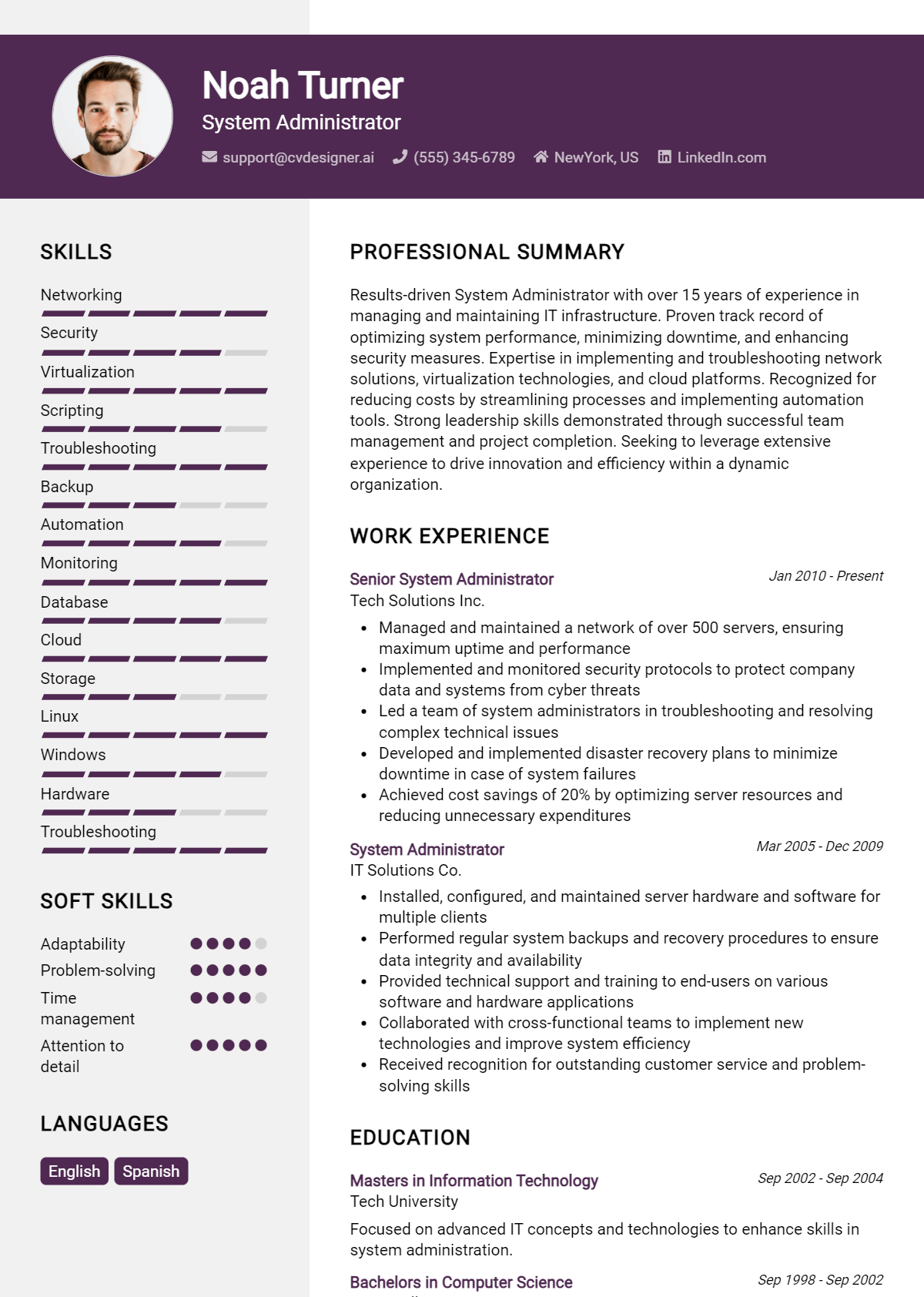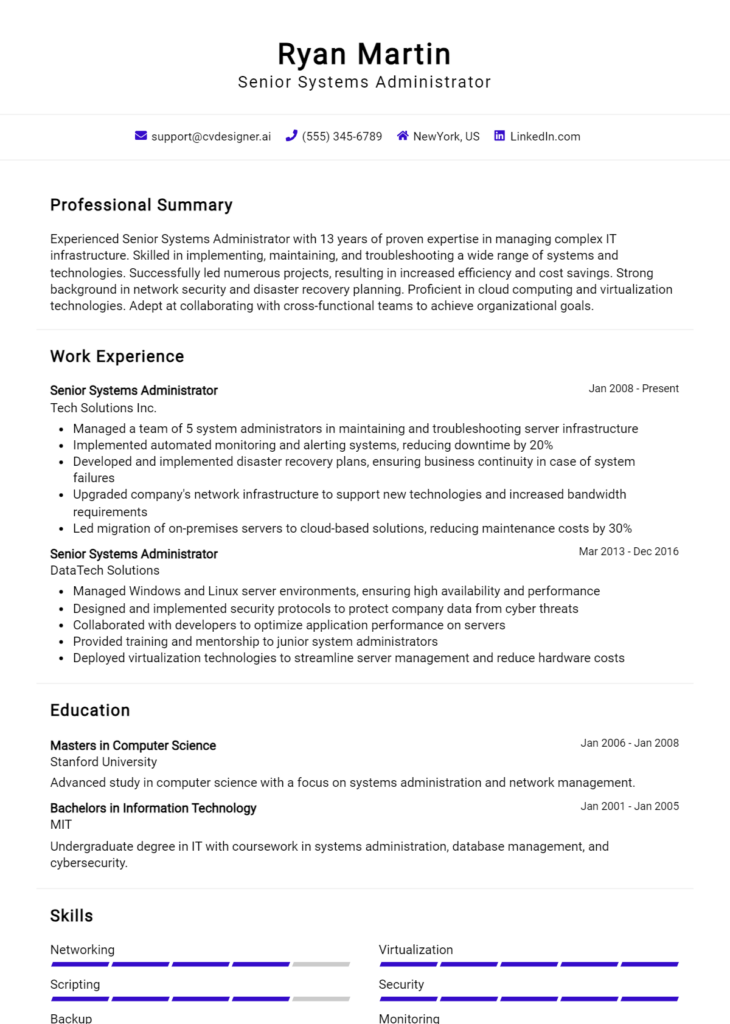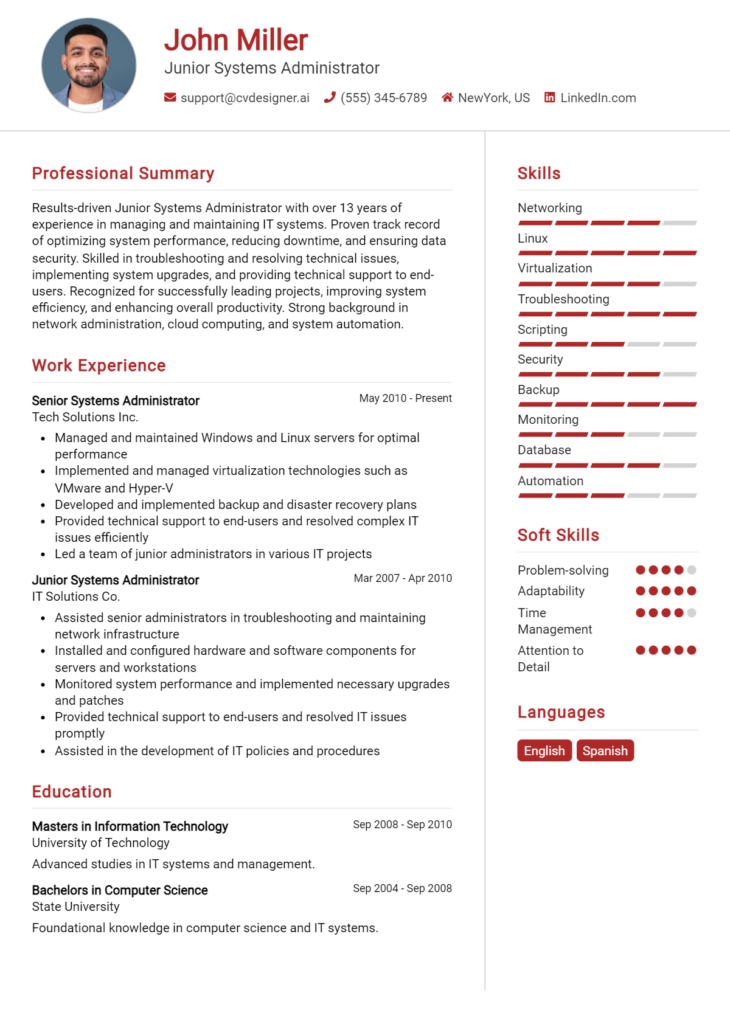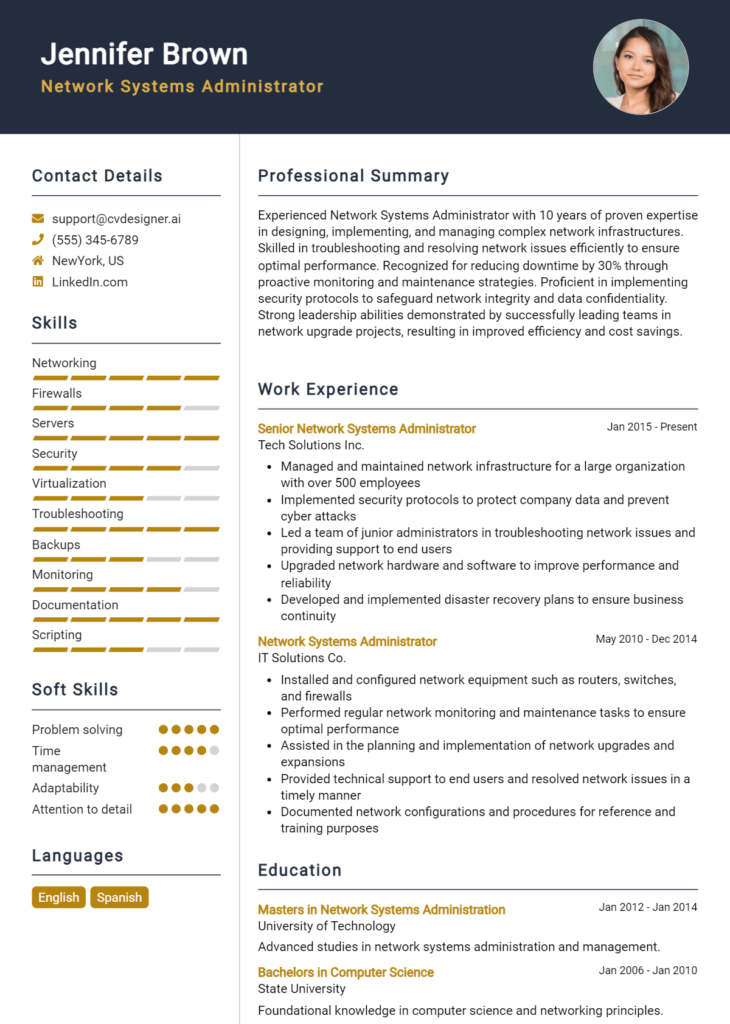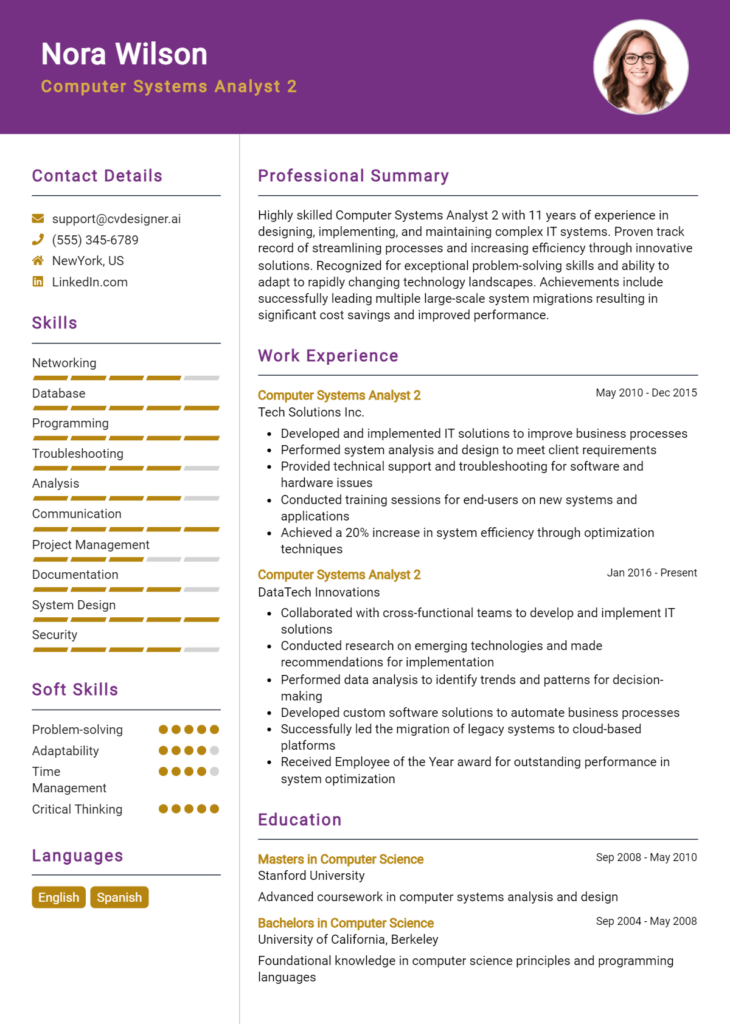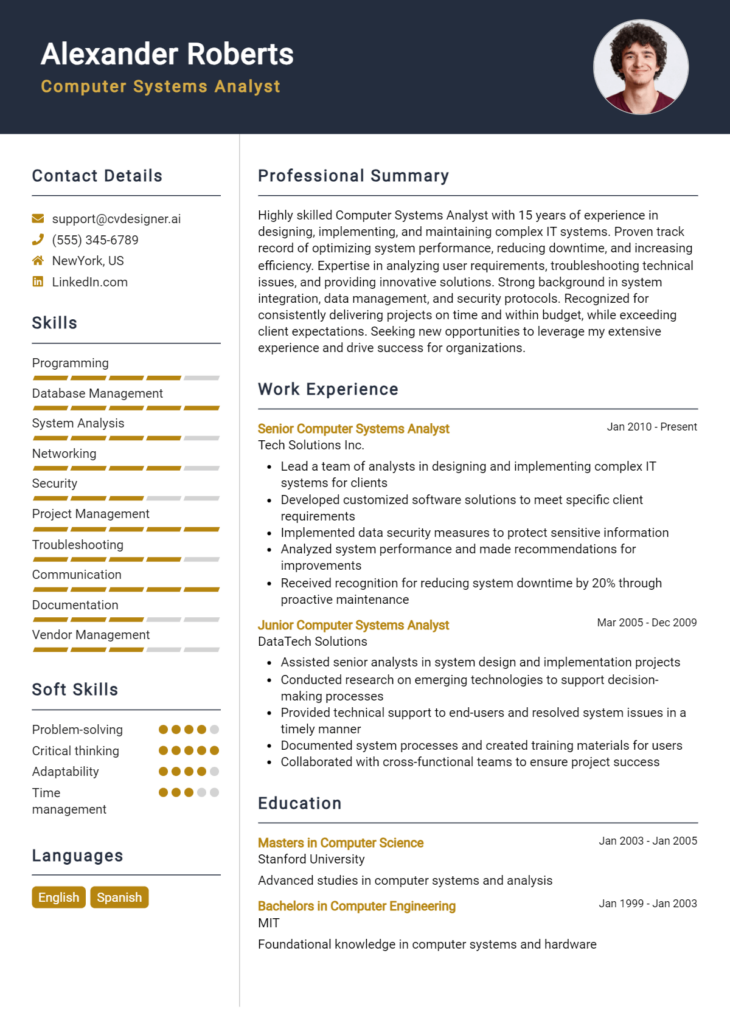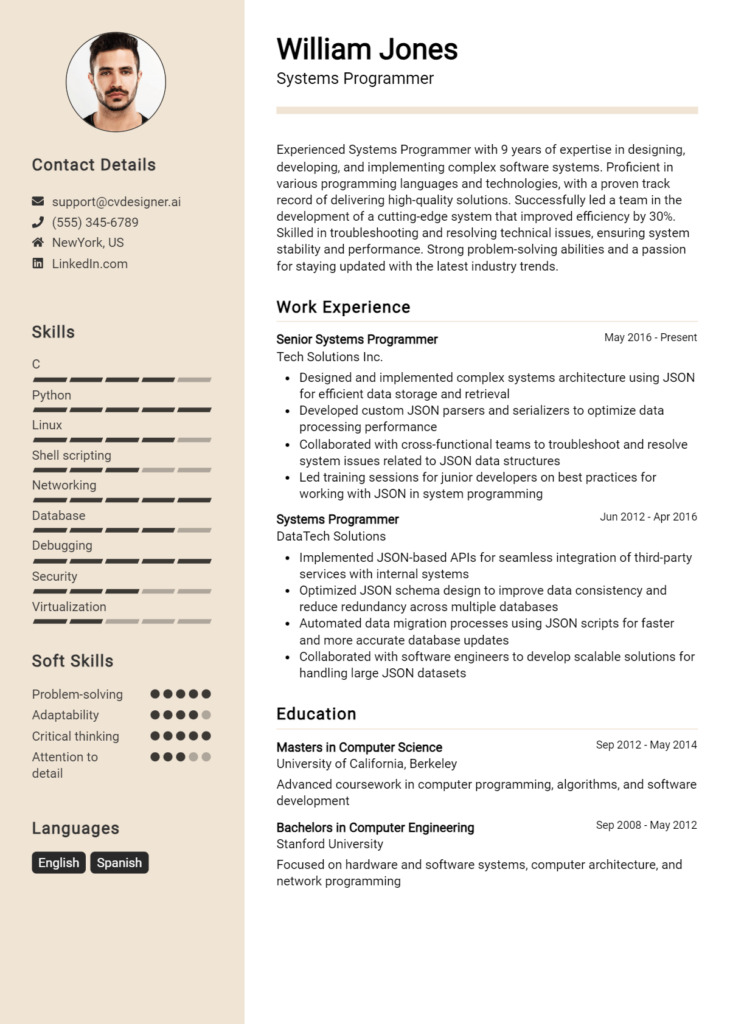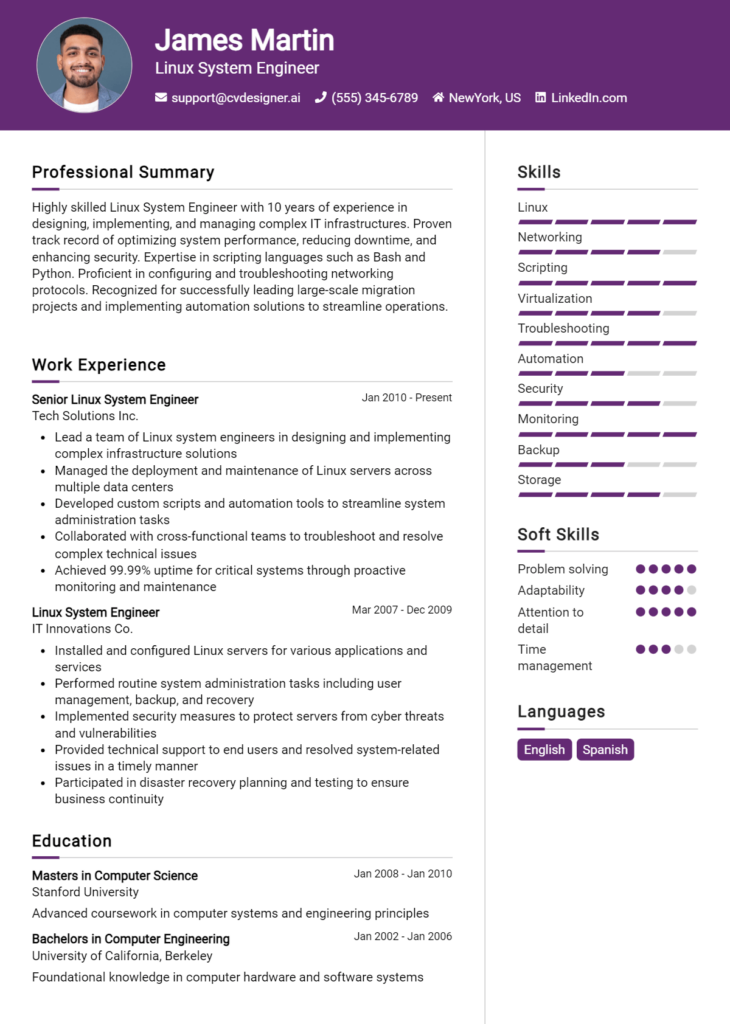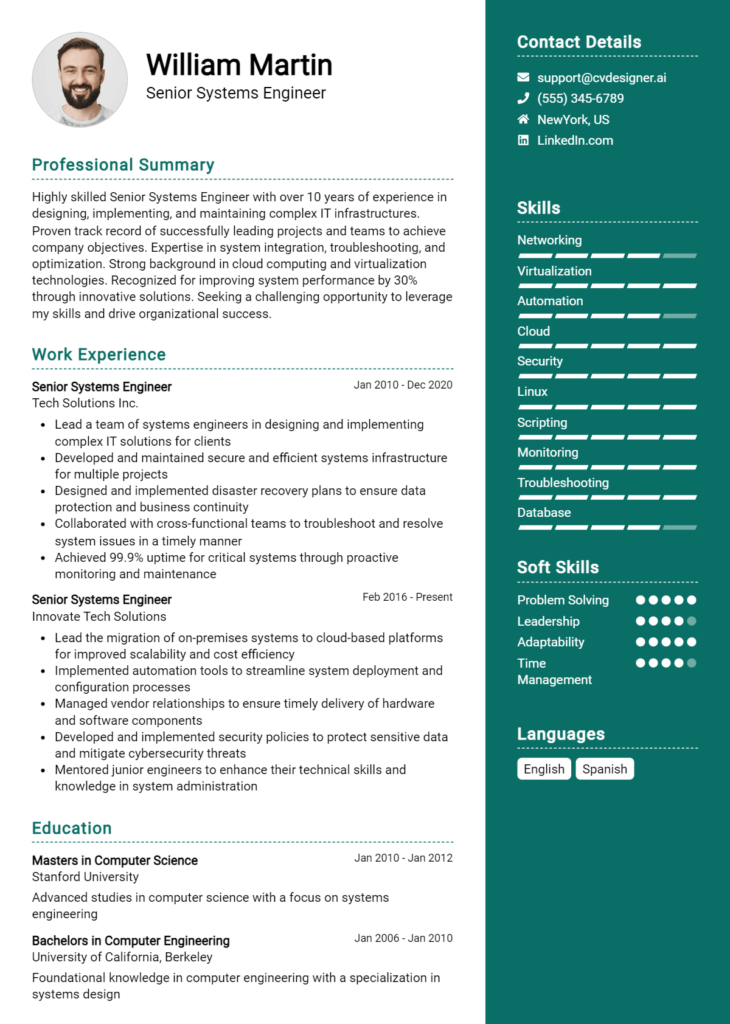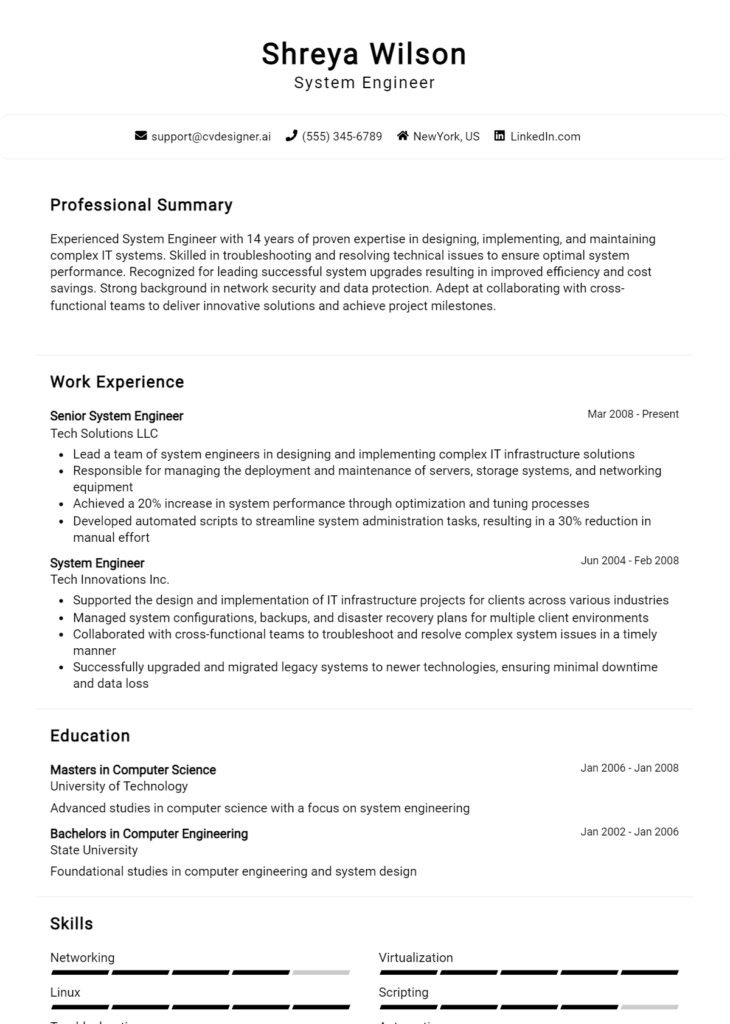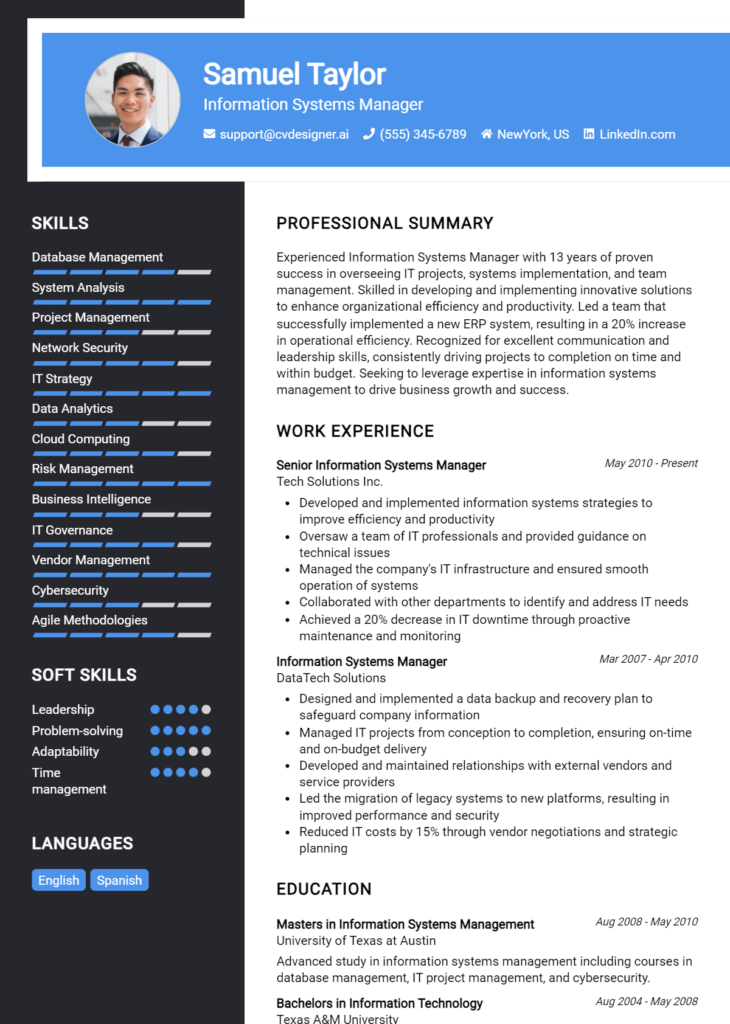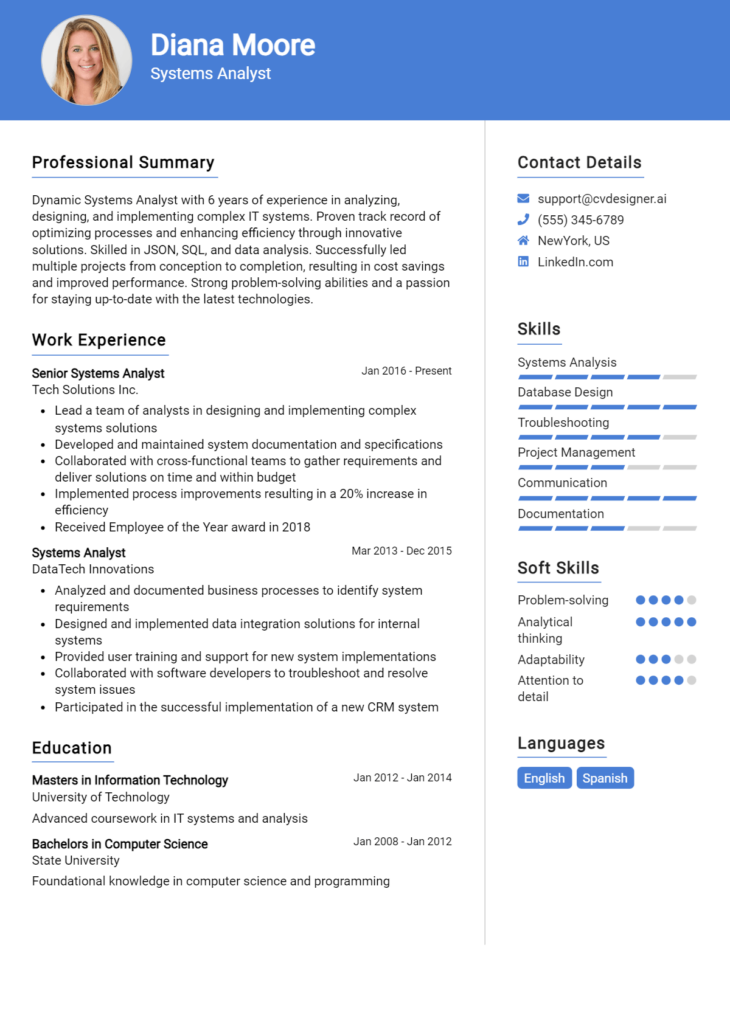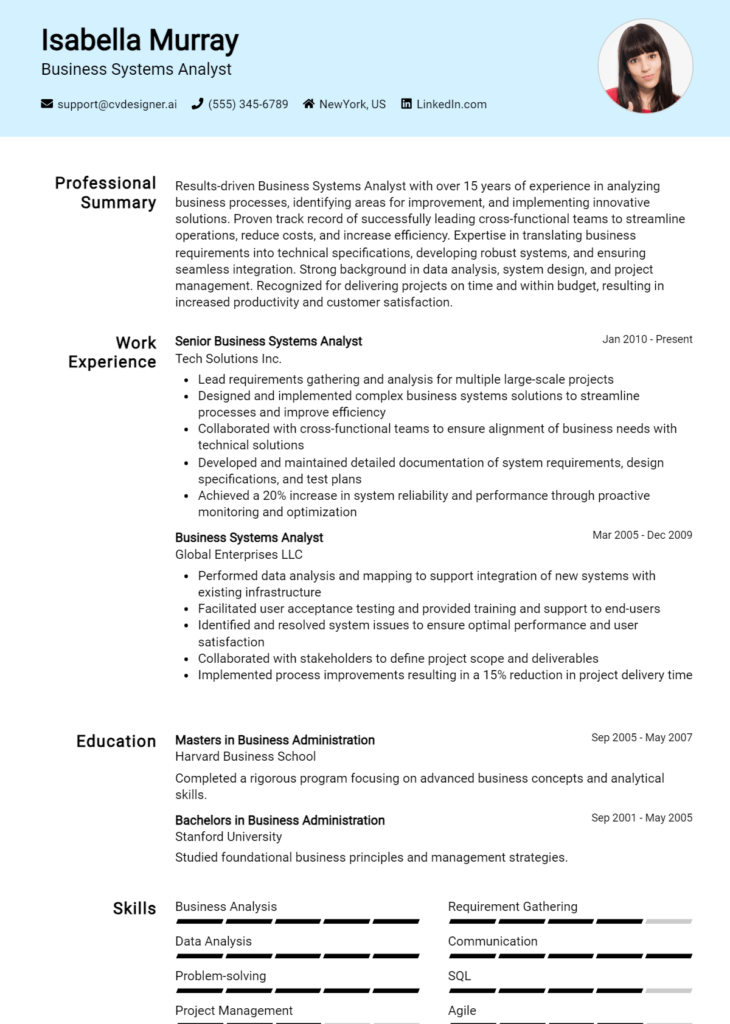Most Popular System Administrator Resume Examples
Explore additional System Administrator resume samples and guides and see what works for your level of experience or role.
As the backbone of any organization's IT infrastructure, the role of a System Administrator is critical to ensuring seamless operations, robust security, and efficient network performance. This demanding position requires a unique blend of technical skills, problem-solving abilities, and a keen understanding of system architecture. Given the competitive nature of the job market, it's essential to present yourself as a standout candidate through a well-crafted resume. A strong resume not only highlights your qualifications and experiences but also showcases your understanding of the role's significance, making it a vital tool in your job search.
In this comprehensive guide to writing a System Administrator resume, we will cover a variety of key points to help you create an effective document that resonates with hiring managers. We'll delve into the specific responsibilities and skills pertinent to the position, explore the best formats to use for maximum impact, and highlight common mistakes to avoid that could undermine your application. Additionally, we'll provide resume examples tailored for all experience levels, along with expert tips on resume writing and selecting the right templates to elevate your presentation. Whether you're a seasoned professional or just starting your career, this guide will equip you with the insights needed to build a compelling resume that opens doors to new opportunities.
Key Responsibilities and Skills for a System Administrator
As a System Administrator, you play a crucial role in managing and maintaining an organization’s IT infrastructure. Your responsibilities include ensuring system availability, performance, and security, as well as providing support to users and troubleshooting technical issues. Below are the key responsibilities typically associated with this role:
- System Maintenance: Regularly monitor and maintain servers, networks, and other infrastructure components to ensure optimal performance.
- User Management: Create and manage user accounts, permissions, and access controls to safeguard sensitive data.
- Backup and Recovery: Implement backup solutions and disaster recovery plans to protect data and ensure business continuity.
- Security Management: Monitor system security, apply patches, and respond to security incidents to mitigate risks.
- Documentation: Maintain accurate documentation of system configurations, processes, and procedures for reference and compliance.
- Technical Support: Provide timely support to users, resolving technical issues and ensuring their productivity.
- System Upgrades: Plan and execute system upgrades and installations, ensuring minimal disruption to operations.
To thrive in this role, certain skills are essential:
- Technical Proficiency: Strong knowledge of operating systems (Windows, Linux), networking, and server management.
- Problem-Solving Skills: Ability to diagnose and troubleshoot issues effectively and efficiently.
- Attention to Detail: Ensure accuracy in system configurations and documentation to avoid errors.
- Communication Skills: Ability to communicate technical information clearly to non-technical users.
- Time Management: Effectively prioritize tasks and manage time to meet deadlines.
Highlighting these skills effectively in your resume skills section is vital for capturing the attention of hiring managers. Tailoring these responsibilities and skills to the specific job description can significantly enhance your chances of being noticed.
Additionally, consider how these skills can be relevant in creating a strong CV. A well-crafted CV that showcases your relevant experience and aligns with the job requirements can set you apart in the competitive job market.
Best Resume Format and Structure for a System Administrator
When crafting a resume for a System Administrator position, it's essential to choose a format that highlights your technical skills, experience, and qualifications effectively. Here’s a detailed guide on the best resume format and structure for a System Administrator.
Contact Information
- Name: Start with your full name at the top of the resume.
- Phone Number: Provide a reliable phone number where you can be reached.
- Email Address: Use a professional email address, ideally a combination of your name and a reputable domain.
- LinkedIn Profile: Include a link to your LinkedIn profile if it showcases your professional achievements and endorsements.
- Location: City and state are usually sufficient; you don’t need to include your full address for privacy reasons.
Professional Summary
- Write a brief summary (2-4 sentences) that highlights your experience, skills, and what you bring to the role.
- Focus on your years of experience, key competencies (like troubleshooting, network management, etc.), and any specific technologies or environments you excel in.
- Tailor this section to align with the job description of the position you are applying for.
Work Experience
- Job Title, Company Name, Location, Dates Employed: List your most recent job first and work backwards.
- Bullet Points: Use bullet points to describe your responsibilities and achievements in each role. Start each bullet with action verbs such as "Managed," "Configured," "Implemented," etc.
- Quantify Achievements: Whenever possible, include numbers or metrics to illustrate your successes (e.g., “Reduced server downtime by 30% through proactive monitoring”).
- Relevant Experience: Focus on experiences that specifically relate to system administration, including server management, network security, and user support.
Education
- Degree, Major, Institution Name, Graduation Date: List your highest degree first. If you have relevant certifications, you might choose to list those here as well.
- Relevant Coursework or Projects: If you are a recent graduate or have completed notable projects, including relevant coursework can add value.
Skills
- Create a bulleted list of technical skills relevant to system administration, such as:
- Operating Systems (Windows, Linux, Unix)
- Networking (TCP/IP, DNS, DHCP)
- Virtualization (VMware, Hyper-V)
- Database Management (SQL, MySQL)
- Scripting Languages (Python, PowerShell)
- Security (firewalls, antivirus, patch management)
- Soft skills like problem-solving, communication, and teamwork are also valuable and should be mentioned if applicable.
Certifications
- List relevant certifications, such as CompTIA A+, Network+, Security+, Microsoft Certified: Azure Administrator Associate, or any vendor-specific credentials.
- Include the certifying body and the date obtained, as well as any recertification dates if applicable.
Tips for Formatting:
- Font and Size: Use professional fonts like Arial, Calibri, or Times New Roman in sizes 10-12 points for text and 14-16 points for headings.
- Margins and Spacing: Keep margins at about 1 inch and use consistent spacing between sections and bullet points for readability.
- Length: A one-page resume is ideal for less experienced candidates, while those with extensive experience can extend to two pages.
- File Format: Save your resume as a PDF to preserve formatting when sending it to potential employers.
The format of your resume should complement your cover letter. A consistent style (fonts, colors, and layout) between the two documents creates a professional appearance. Your cover letter should expand on your resume, providing deeper insights into your experiences and motivations for applying to the specific role. This cohesion reinforces your professional brand and makes a strong impression on potential employers.
Writing Tips and Best Practices for a System Administrator Resume
When crafting a resume as a System Administrator, it's crucial to present your technical skills and experiences in a clear, concise manner. Focus on highlighting your expertise with specific systems, tools, and methodologies relevant to the role. Use a professional format to ensure readability, and consider leveraging resume writing tips to enhance the visual appeal of your document. Remember, your resume is your first impression—make it count! Additionally, the same principles you apply here will also serve you well in your cover letter.
- Use action verbs to start each bullet point, such as "Configured," "Managed," or "Implemented," to convey your role in each achievement.
- Quantify your accomplishments when possible, e.g., “Managed a network of 200+ users” or “Reduced system downtime by 30% through proactive maintenance.”
- Incorporate industry-specific keywords and phrases that match the job description to help your resume pass through Applicant Tracking Systems (ATS).
- Tailor your resume for each position by aligning your skills and experiences with the requirements listed in the job posting.
- Keep your resume to one or two pages, focusing on the most relevant experiences and skills that demonstrate your qualifications for the role.
- Highlight certifications and training that are pertinent to the field, such as CompTIA, Cisco, or Microsoft certifications.
- Use bullet points for easy readability, ensuring each point is clear and concise.
- Proofread for grammar and spelling errors, as attention to detail is critical in the System Administrator role.
Common Mistakes to Avoid in a System Administrator Resume
Crafting a compelling resume as a System Administrator is crucial for capturing the attention of potential employers. However, many candidates fall into common traps that can undermine their chances of securing an interview. To stand out in this competitive field, it's essential to avoid these mistakes that can detract from your qualifications and experience. Here are some common pitfalls to watch out for:
- Overloading the resume with excessive information, leading to clutter and confusion.
- Using generic descriptions that fail to highlight specific skills and achievements.
- Failing to tailor the resume to the specific job description or company needs.
- Ignoring the importance of formatting, which can make the document hard to read.
- Listing responsibilities instead of focusing on accomplishments and results.
- Using technical jargon without providing context or explanation.
- Neglecting to include relevant certifications or training that enhance qualifications.
- Writing in lengthy paragraphs instead of using bullet points for clarity.
- Omitting keywords that applicant tracking systems (ATS) look for in resumes.
- Including outdated or irrelevant experience that doesn’t align with the job.
To ensure you present your skills and experience effectively, consider reviewing the common mistakes to avoid in a resume and also take a look at the common cover letter mistakes that should be avoided, as both documents are essential for making a strong first impression.
Sample System Administrator Resumes
As a System Administrator, you play a critical role in maintaining and managing an organization’s IT infrastructure, ensuring that systems operate smoothly and securely. Crafting a compelling resume is essential to highlight your skills and experiences in this dynamic field. Below are three sample resumes tailored for various levels of experience, showcasing the diverse backgrounds and qualifications of System Administrators. Feel free to explore more resume templates for additional inspiration, and don't forget that corresponding cover letter examples can enhance your job application package.
Experienced Professional System Administrator Resume
John Doe
123 Tech Lane, Silicon Valley, CA 94016
(123) 456-7890
john.doe@email.com
Professional Summary
Dedicated and results-driven System Administrator with over 8 years of experience in managing and supporting complex IT infrastructures. Proven expertise in network administration, system security, and performance optimization, with a strong commitment to delivering high-quality solutions that enhance operational efficiency.
Technical Skills
- Operating Systems: Windows Server, Linux, Unix
- Virtualization: VMware, Hyper-V
- Networking: TCP/IP, DNS, DHCP, VPN
- Security: Firewalls, Antivirus, Intrusion Detection Systems
- Tools: PowerShell, Bash, Active Directory, SQL Server
Professional Experience
Senior System Administrator
ABC Technologies, Silicon Valley, CA
January 2018 – Present
- Managed a team of junior administrators, overseeing the deployment and configuration of servers and network systems.
- Implemented security policies and procedures, reducing security incidents by 30%.
- Conducted regular system audits and performance tuning, improving server uptime to 99.9%.
System Administrator
XYZ Corp, San Francisco, CA
June 2015 – December 2017
- Supported daily operations of Windows and Linux servers, ensuring high availability and performance.
- Collaborated with IT teams to design and implement network infrastructure for new office locations.
- Developed automated scripts for system monitoring, significantly reducing response time to issues.
Education
Bachelor of Science in Information Technology
University of California, Berkeley
Graduated: May 2015
Entry-Level System Administrator Resume
Emily Smith
456 Tech Street, Austin, TX 73301
(987) 654-3210
emily.smith@email.com
Professional Summary
Motivated and detail-oriented recent graduate with a Bachelor’s degree in Information Technology. Eager to leverage skills in system administration and support to contribute to an organization’s IT success. Possesses a solid understanding of network protocols and system security.
Technical Skills
- Operating Systems: Windows 10, Linux
- Networking: Basic knowledge of TCP/IP, DNS, DHCP
- Tools: Active Directory, VMware, PowerShell
- Security: Familiarity with firewalls and antivirus software
Professional Experience
IT Intern
Tech Solutions, Austin, TX
May 2022 – August 2022
- Assisted senior administrators in maintaining network integrity and troubleshooting system issues.
- Helped in the setup and configuration of new workstations and servers.
- Conducted user training sessions for software applications and security best practices.
Education
Bachelor of Science in Information Technology
University of Texas, Austin
Graduated: May 2022
Career Changer System Administrator Resume
Michael Johnson
789 New Path Road, Seattle, WA 98101
(321) 654-9870
michael.johnson@email.com
Professional Summary
Detail-oriented professional transitioning from a career in technical support to system administration. Experienced in providing excellent customer service and troubleshooting technical issues. Eager to apply strong analytical skills and a passion for technology to a System Administrator role.
Technical Skills
- Operating Systems: Windows, Linux
- Networking: Basic understanding of TCP/IP and DNS
- Tools: Active Directory, Help Desk Software, VMware
- Security: Knowledge of security protocols and best practices
Professional Experience
Technical Support Specialist
Support Services, Seattle, WA
March 2019 – Present
- Provided technical assistance to clients, resolving issues related to software and hardware.
- Documented technical processes and created user manuals to improve customer support.
- Collaborated with IT teams to escalate and resolve complex technical problems.
Education
Associate Degree in Computer Science
Seattle Community College
Graduated: June 2018
By utilizing these examples as a foundation, you can create a compelling resume that showcases your qualifications as a System Administrator, regardless of your experience level. Don't forget to check out the available resume templates and cover letter examples to complete your application package effectively.
Checklist for a System Administrator Resume
- Proofread for Typos and Grammar: Carefully read through your resume to catch any spelling or grammatical errors. Consider using tools like Grammarly or ask a friend to review it for you.
- Check for Consistency: Ensure that formatting is consistent throughout the document, including font style, size, bullet points, and spacing. Consistency reflects professionalism.
- Tailor to the Job Description: Modify your resume to align with the specific job description. Highlight relevant skills, experiences, and keywords that match the requirements of the System Administrator role.
- Highlight Relevant Skills: Clearly list technical skills such as network management, system security, and troubleshooting. Use bullet points for easy readability and emphasize those that are most pertinent to the position.
- Use Action Verbs: Start bullet points with strong action verbs like "managed," "configured," "implemented," or "optimized" to convey your contributions effectively.
- Quantify Achievements: Where possible, use numbers to quantify your achievements. For example, "Reduced system downtime by 30% through proactive monitoring and maintenance."
- Include Certifications: List relevant certifications such as CompTIA A+, Microsoft Certified: Azure Administrator Associate, or any other pertinent qualifications that enhance your expertise.
- Focus on Results: Highlight accomplishments that demonstrate your impact in previous roles. For example, mention how you improved system performance or enhanced security measures.
- Keep it Concise: Aim to keep your resume to one page, especially if you have less than 10 years of experience. Be succinct and only include the most relevant information.
- Consider Using an AI Resume Builder: To ensure all elements are well-organized and visually appealing, consider using an AI resume builder.
A similar checklist can also be followed for creating a CV or cover letter to maintain coherence and professionalism in your job application materials.
Key Takeaways for a System Administrator Resume Guide
In conclusion, crafting a strong System Administrator resume is essential for showcasing your technical skills and experience in a competitive job market. By leveraging the provided examples and tips, you can create a resume that effectively highlights your qualifications and sets you apart from other candidates. We encourage you to take the next step in your job search by downloading a professionally designed template from resume templates or a tailored cover letter template. For a more personalized approach, consider using our best resume maker to ensure your resume stands out. Additionally, remember that following similar guidelines will also support you in crafting a compelling CV and cover letter. Start building your path to success today!
